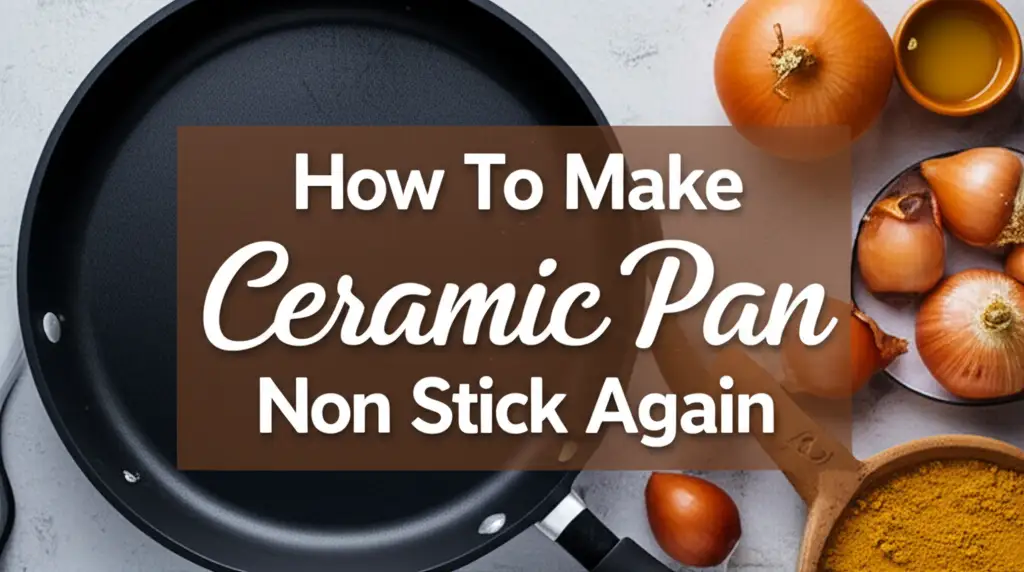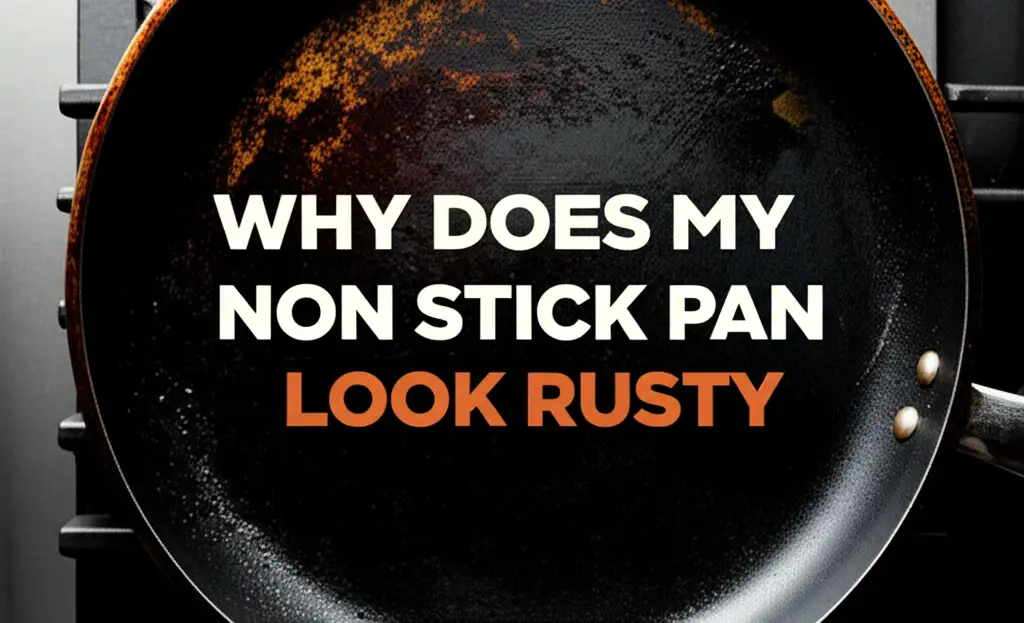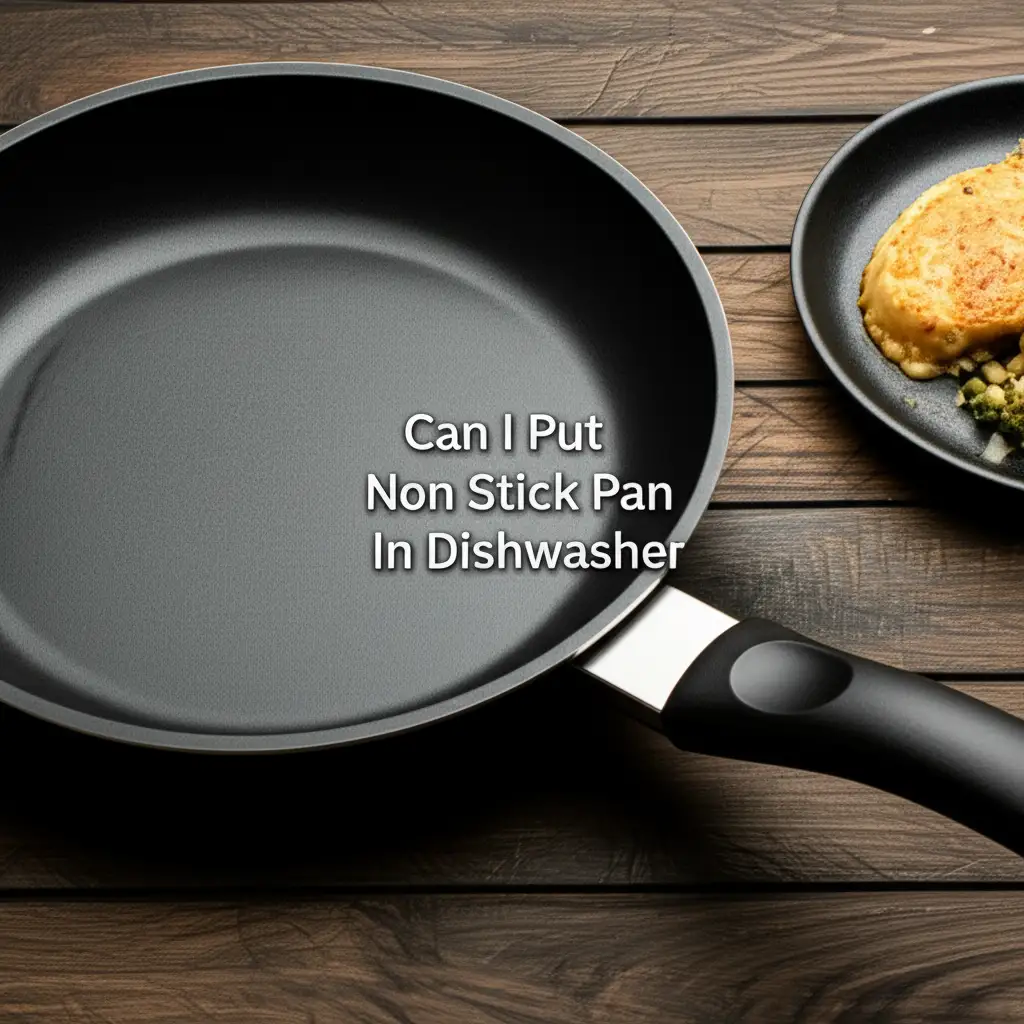· Todd Martin · Cookware Care · 13 min read
How To Make Ceramic Pan Non Stick Again

Revive Your Ceramic Pan: How To Make It Non Stick Again
You depend on your ceramic pan for effortless cooking. It brings joy when eggs slide right off. But what happens when food starts to stick? It is a common problem. Your once reliable non-stick ceramic pan can become a source of kitchen frustration.
Many people think a sticky ceramic pan is ready for the trash. This is often not true. You can bring back its non-stick properties. You can save money and prolong the life of your favorite pan. This article guides you through the simple steps. We will cover cleaning, re-seasoning, and proper care. You will learn how to make ceramic pan non stick again.
Takeaway
- Deep Clean: Remove food residue and mineral buildup from the pan.
- Re-Season: Create a new non-stick layer with oil and low heat.
- Use Proper Care: Avoid high heat, harsh tools, and abrasive cleaners.
- Store Correctly: Protect the surface from scratches.
- Understand Limits: Know when a pan is beyond repair.
You can make your ceramic pan non stick again by thoroughly cleaning it to remove sticky residue and then re-seasoning the surface with a thin layer of oil heated gently. Regular proper cleaning and mindful cooking practices will help maintain its non-stick qualities.
Why Ceramic Pans Lose Their Non-Stick Quality
Ceramic pans are popular for their non-stick surfaces. They make cooking and cleaning easier. However, these pans can lose their non-stick properties over time. Understanding why this happens helps you fix the issue. It also helps you prevent future problems.
One main reason is residue buildup. Cooking oils and food particles can leave behind a thin film. This film bakes onto the surface with each use. Over time, this buildup creates a rough surface. This rough surface makes food stick. Regular washing might not remove all of it.
Another cause is overheating. Ceramic coatings are durable. They can handle moderate heat. However, very high temperatures damage the surface. The coating can break down. This breakdown makes it less effective. Always use medium or low heat with ceramic pans. Excessive heat is a common problem. It can even make a new pan stick. Learn more about why your new non-stick pan might stick.
Scratches also hurt performance. Metal utensils or abrasive sponges can scratch the ceramic. These scratches create rough spots. Food sticks easily to these damaged areas. Always use wooden, silicone, or plastic tools. Avoid harsh scrubbing pads. These simple actions protect your pan.
Lastly, improper cleaning can contribute. Using harsh detergents or dishwashers can strip away natural oils. These oils help maintain the non-stick property. Always hand wash your ceramic pans. Use mild soap and a soft sponge. This gentle approach preserves the coating. Understanding these factors is the first step to restore your pan.
Deep Cleaning: The First Step to Restore Non-Stick
A thorough cleaning is the most important step. It removes old food residue and oil buildup. This buildup makes your ceramic pan stick. You need to remove all sticky layers. This process creates a fresh surface. You can then re-season the pan.
Start with a warm water soak. Fill the pan with warm water. Add a few drops of dish soap. Let it sit for 15-20 minutes. This softens any stuck-on food. It makes scrubbing easier. After soaking, gently scrub the pan. Use a soft sponge or a microfiber cloth. Never use steel wool or abrasive scrubbers.
For stubborn stains, baking soda works well. Make a paste with baking soda and water. Apply this paste to the sticky areas. Let it sit for 10-15 minutes. The baking soda helps lift the grime. Then, gently scrub the paste away. Rinse the pan well with warm water. This method is effective for many non-stick pans. You can find more tips on how to clean a non-stick frying pan.
Vinegar is another useful cleaner. White vinegar helps dissolve mineral deposits. It also removes grease. Mix equal parts white vinegar and water in the pan. Bring it to a gentle boil for 5-10 minutes. Let it cool, then wash it. This method works wonders on burnt areas. Learn more about how to clean a burnt non-stick pan. You can also combine vinegar and baking soda for a powerful clean. Discover how to clean a non-stick pan with vinegar and baking soda.
After cleaning, dry the pan completely. Any moisture can hinder the re-seasoning process. A clean, dry surface is essential. It lets the new oil layer bond properly. This deep cleaning sets the stage for a successful restoration.
Re-Seasoning Your Ceramic Pan for Peak Performance
After a deep clean, re-seasoning is crucial. This process creates a fresh, non-stick layer. It helps to make ceramic pan non stick again. Re-seasoning protects the surface. It also ensures food slides off easily. This simple step can greatly improve your pan’s performance.
First, make sure your pan is completely clean and dry. Any water or residue will stop the oil from bonding. Place the clean, dry ceramic pan on your stovetop. Set the heat to low or medium-low. You want the pan to warm gently. Avoid high heat during this step.
Next, add a small amount of cooking oil. Choose an oil with a high smoke point. Good choices include grapeseed oil, flaxseed oil, or refined coconut oil. You only need about half a teaspoon. Too much oil will make the pan greasy. It can also create a sticky mess later.
Use a paper towel to spread the oil. Spread it evenly over the entire interior surface. Make sure the oil covers the bottom and sides. Wipe off any excess oil. The goal is a very thin, almost invisible, layer. You do not want pooling oil.
Heat the pan on low for a few minutes. You might see a faint wisp of smoke. This means the oil is bonding. Turn off the heat. Let the pan cool down completely. Repeat this process 2-3 times for best results. Each layer adds to the non-stick quality. This re-seasoning works for many types of pans. Learn if you can make your frying pan non-stick again. A properly seasoned pan will feel smooth and slick.
Daily Care Habits for Long-Lasting Non-Stick
Maintaining your ceramic pan’s non-stick surface requires daily care. Simple habits keep your pan performing well. These practices prevent the problems that cause sticking. Good daily care means less need for deep cleaning and re-seasoning. It ensures your pan stays non-stick for longer.
Always use appropriate cooking temperatures. Ceramic pans work best with low to medium heat. High heat can break down the non-stick coating. It causes food to stick. It also reduces the pan’s lifespan. Preheat your pan gently. Give it a few minutes to warm up.
Choose the right cooking utensils. Metal spatulas and spoons can scratch ceramic. These scratches damage the non-stick surface. Always use silicone, wood, or plastic tools. This protects the delicate coating. Scratches are a major cause of sticking.
Clean your pan gently after each use. Let the pan cool down completely before washing. Pouring cold water on a hot pan can cause warping. It can also damage the coating. Use warm water, mild dish soap, and a soft sponge. Avoid abrasive scrubbers. Do not put ceramic pans in the dishwasher. The harsh detergents and high heat can ruin the coating. For new pans, it’s good to know how to clean a non-stick pan before first use.
Store your ceramic pan carefully. Do not stack other pans directly inside it. This can scratch the non-stick surface. Place a pan protector between stacked pans. You can use a paper towel or a soft cloth. Hanging your pans is another good option. These simple steps protect the coating from damage. Consistent care makes a big difference.
Avoiding Common Mistakes That Damage Ceramic Coatings
Many common kitchen habits can harm your ceramic pan. Avoiding these mistakes extends its non-stick life. Knowing what to avoid is as important as knowing what to do. These simple changes protect your pan’s delicate surface. They ensure your pan remains non-stick.
One major mistake is using cooking sprays. Many cooking sprays contain propellants and additives. These ingredients can build up on the ceramic surface. This creates a sticky, hard-to-remove residue. This residue makes your food stick. Instead, use a small amount of regular cooking oil. Spread it thinly across the pan.
Do not use metal utensils. This point bears repeating. Metal spoons, spatulas, and whisks scratch the ceramic coating. Even small scratches ruin the non-stick property. Always opt for silicone, wooden, or heat-resistant plastic tools. They are gentle on the surface. Find out if you can use a steel spoon in a non-stick pan. The answer is usually no for ceramic pans.
Avoid extreme temperature changes. Pouring cold water into a hot pan is bad. This sudden shock can warp the pan. It can also cause the ceramic coating to crack or lift. Always let your pan cool down naturally before washing. This helps prevent damage.
Using abrasive cleaners or scouring pads is another mistake. These materials are too harsh for ceramic. They will scratch and wear away the non-stick layer. Stick to soft sponges and mild dish soap. For tough spots, use baking soda paste. These gentle methods clean effectively without causing harm. Proper use prevents many issues.
Specialized Treatments for Stubborn Stickiness
Sometimes, regular cleaning is not enough. Stubborn stickiness requires a bit more effort. These specialized treatments can help restore your ceramic pan’s non-stick properties. They target baked-on residue that resists simple washing. These methods are gentle but effective.
One effective treatment uses lemon juice. Lemon juice is acidic. It helps break down greasy buildup. Squeeze the juice of one lemon into the pan. Add an equal amount of water. Bring this mixture to a gentle simmer for 5-10 minutes. Let it cool completely. Then, wash the pan with mild soap and a soft sponge. The acidity helps loosen stuck-on grime.
Another option is a salt paste. This method provides gentle abrasion. Mix a few tablespoons of coarse salt (like kosher or sea salt) with a small amount of water. Form a thick paste. Apply the paste to the sticky areas of the pan. Gently rub the paste with a soft sponge or cloth. Do not scrub hard. The salt helps lift residue without scratching. Rinse the pan thoroughly afterward. Ensure all salt is gone.
For extreme buildup, a gentle boil-off might be needed. Fill the pan with water. Add a few drops of dish soap. Place it on the stove and bring it to a boil. Let it simmer for 10-15 minutes. The boiling water and soap help loosen burned-on food. Turn off the heat and let the water cool. Then, carefully scrub with a soft brush or sponge. This method can help clean severely burnt pans.
After any specialized treatment, always re-season your pan. The powerful cleaning might remove the current oil layer. Re-seasoning restores the protective non-stick film. These treatments help extend the life of your ceramic pan. They help you make ceramic pan non stick again.
Knowing When to Say Goodbye: Pan Replacement Signs
Even with the best care, pans do not last forever. Ceramic non-stick coatings have a lifespan. It is important to know when your pan is beyond repair. Continuing to use a damaged pan can be frustrating. It can also lead to uneven cooking. Recognizing these signs helps you make the right decision.
One clear sign is extensive scratching. If your pan has deep, widespread scratches, its non-stick property is gone. Food will stick severely to these areas. Re-seasoning cannot fix deep physical damage. Small, superficial scratches might be okay. But many deep ones mean it is time for a new pan.
Peeling or flaking coating is another major indicator. If the ceramic coating is visibly peeling off, discard the pan. Eating food cooked in a pan with flaking coating is not recommended. This means the pan’s surface is breaking down. It has reached the end of its useful life.
Warping is also a problem. A warped pan does not sit flat on the stove. This leads to uneven heat distribution. Food will cook poorly. You cannot easily fix a warped pan. Warping often happens from sudden temperature changes. It means the pan’s structure is compromised.
If food consistently sticks, despite cleaning and re-seasoning, your pan might be worn out. You have tried all the steps to make ceramic pan non stick again. If nothing works, the coating may be too degraded. At this point, a new pan will give you better cooking results. Understanding how to know if your non-stick pan is bad helps. Investing in a new pan can save you future frustration. It ensures your meals cook as they should.
FAQ Section
How often should I re-season my ceramic pan?
You should re-season your ceramic pan when food starts to stick. This usually happens after a few months of regular use. Re-season after a deep clean. It is not necessary after every single use. Keep an eye on its performance.
Can I use olive oil to season my ceramic pan?
Yes, you can use olive oil. However, extra virgin olive oil has a low smoke point. It can burn and leave residue. Choose refined olive oil or other high smoke point oils. Grapeseed or flaxseed oil are better choices for seasoning.
Is it safe to cook on a ceramic pan that has lost its non-stick?
Cooking on a ceramic pan that lost its non-stick is generally safe. The main issue is food sticking. The pan becomes harder to use. If the coating is peeling, it is best to replace it. Small flakes of coating might get into food.
Can dishwashers damage ceramic non-stick pans?
Yes, dishwashers can damage ceramic non-stick pans. The high heat and harsh detergents degrade the coating. This reduces its non-stick ability. Always hand wash ceramic pans with mild soap and a soft sponge.
What should I do if my ceramic pan smells burnt?
If your ceramic pan smells burnt, it likely has baked-on residue. Deep clean it thoroughly using baking soda or vinegar. Follow with re-seasoning. Ensure you do not overheat the pan during cooking. Overheating causes residue to burn.
Conclusion
A sticky ceramic pan does not have to be a lost cause. You now understand how to make ceramic pan non stick again. It starts with proper care. It also involves effective cleaning and simple re-seasoning. These steps can bring your pan back to life. You can restore its smooth, easy-release surface.
Remember to deep clean your pan. Remove all baked-on residue and oil buildup. Then, re-season it with a thin layer of high-smoke-point oil. Practice good daily habits. Use low to medium heat. Choose silicone or wooden utensils. Always hand wash your pan gently. Avoid abrasive cleaners and cooking sprays. These small changes make a big difference.
By following these tips, you will extend your pan’s life. You will enjoy effortless cooking once more. Do not give up on your ceramic pan too quickly. Take action today. Restore its non-stick glory. Get back to cooking with ease.





